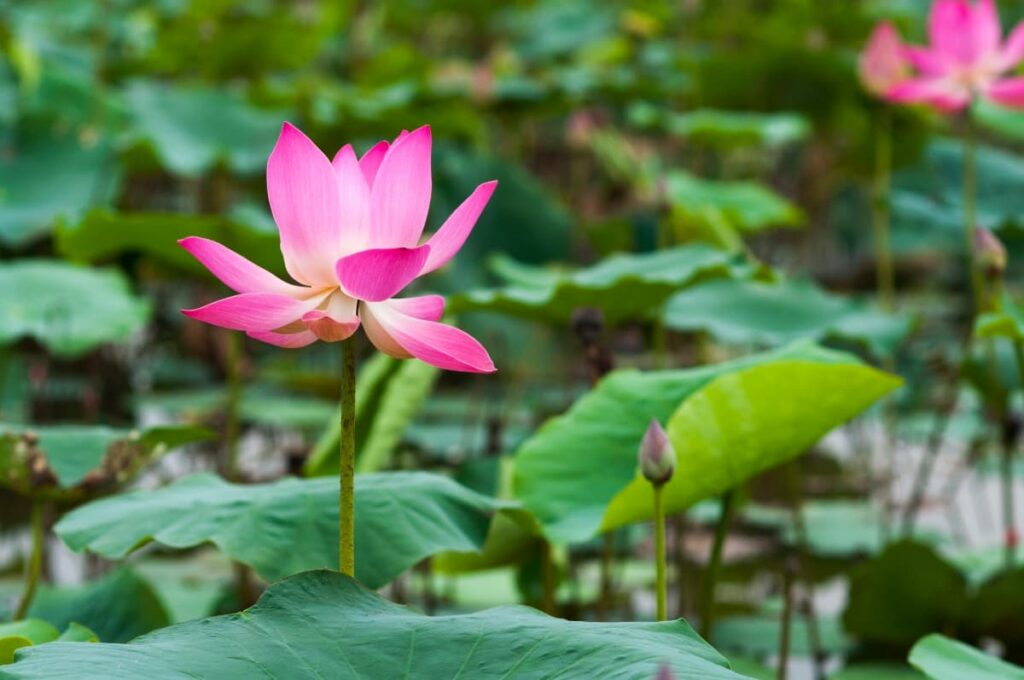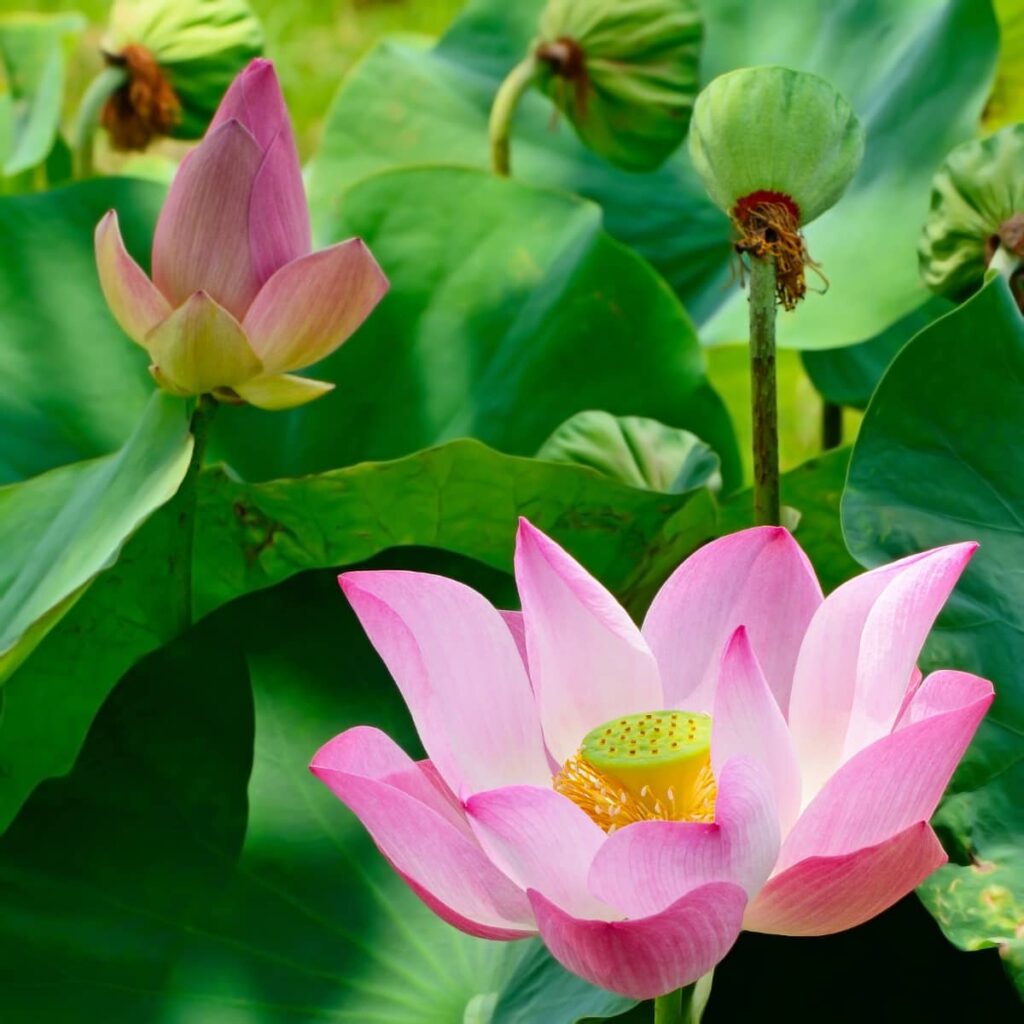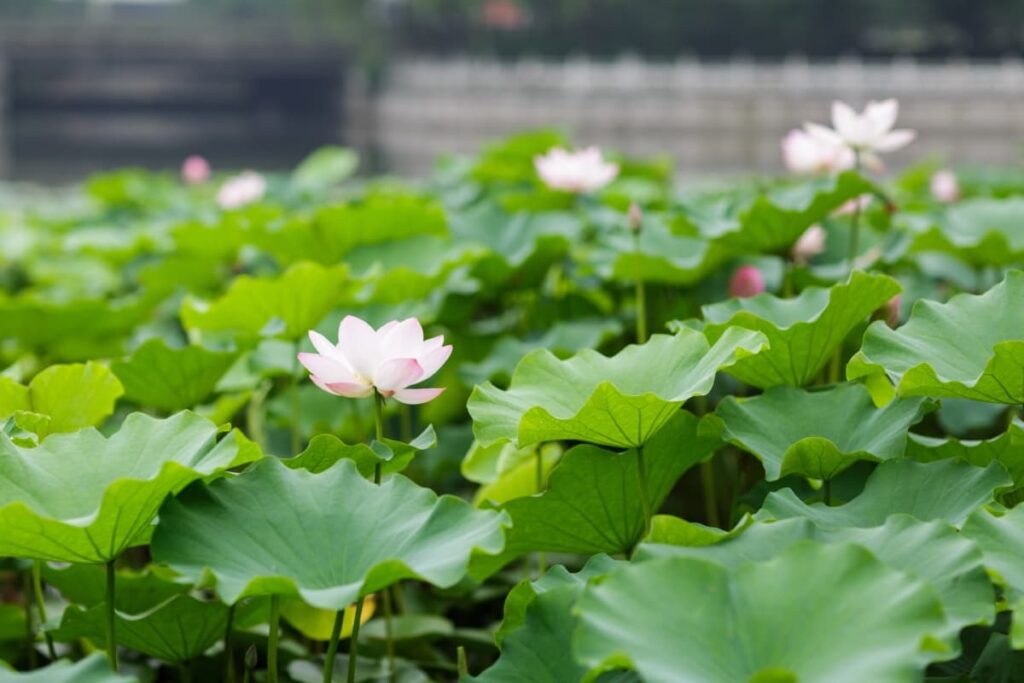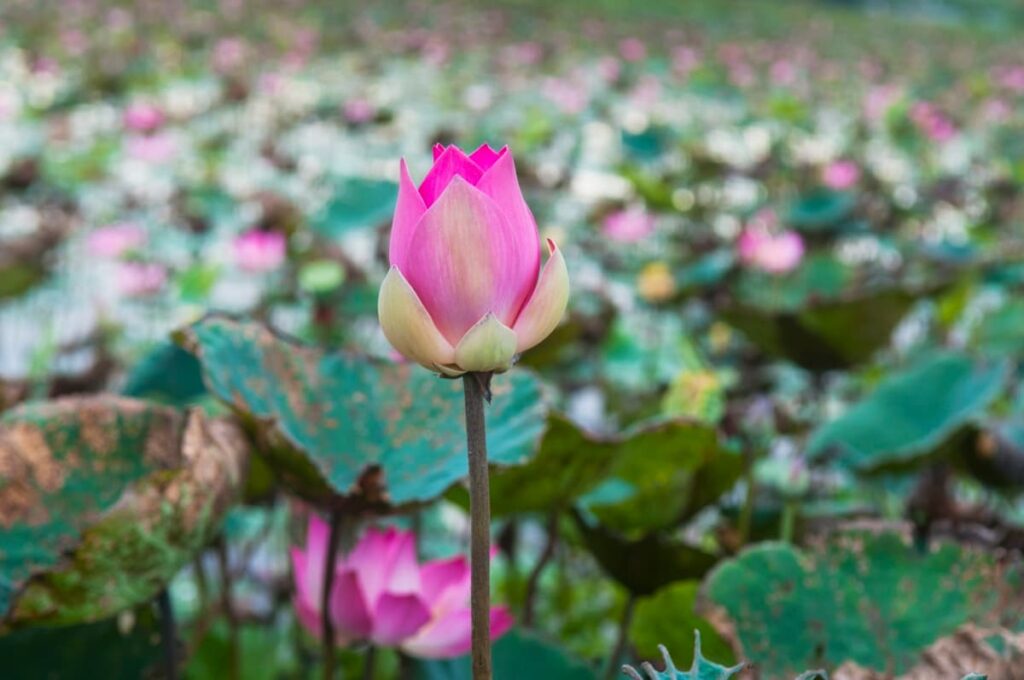The Lotus (Nelumbo nucifera) is more than just a plant; it’s a symbol of purity and enlightenment in many cultures. This perennial aquatic wonder belongs to the small family of Nelumbonaceae, standing out with its exquisite blooms and distinct circular leaves. There could be a few reasons why your Lotus is not flowering as expected. If you address these issues, your Lotus plant should start blooming beautifully. By implementing some effective techniques, you can support your Lotus plant in producing stunning blooms throughout the season.

10 Reasons Why Your Lotus Plant is Not Blooming
Inadequate Sunlight Exposure
Lotus plants thrive in full sun, requiring 6 to 8 hours of sunlight to produce beautiful blooms. If your Lotus is not getting enough sunlight, it may struggle to photosynthesize effectively and develop flower buds. Ensure that no obstructions are blocking the sun’s rays from reaching your plant, such as overhanging trees or structures.
Consider relocating your Lotus plant to a spot in your pond where it can receive ample sunlight throughout the day. By addressing this issue, you may encourage your Lotus to bloom abundantly and enhance the overall aesthetic appeal of your aquatic garden.
Insufficient Nutrient Levels
Lotus plants require a good balance of nutrients to thrive and produce beautiful flowers. When your Lotus plant lacks essential nutrients like nitrogen, phosphorus, and potassium, its growth and flowering can be negatively impacted. Without the right nutrients, the plant may struggle to develop healthy blooms. Regularly monitoring your Lotus plant’s response to fertilization is key. Adjusting the feeding schedule for Lotus or the type of fertilizer based on its performance can help optimize blooming potential and overall health.
To address this issue, consider using a high-quality aquatic fertilizer specifically designed for water lilies and Lotus plants. These fertilizers are formulated to provide the necessary nutrients in the right proportions to support robust growth and abundant flowering. Regularly feeding your Lotus plant with a balanced fertilizer can help ensure that it receives adequate nutrition to bloom vibrantly throughout the growing season.
Incorrect Water Depth
Lotus plants are quite particular about their aquatic environment, including the depth of the water they’re growing in. If the water is too shallow, it can lead to inadequate root development and hinder the plant’s ability to absorb nutrients efficiently. On the contrary, if the water is too deep, it may cause stress to the plant by drowning its roots or limiting oxygen uptake.
To ensure optimal blooming of your Lotus plant, make sure that it is planted at a suitable depth where its leaves float on top of the water but its roots are well submerged below. This balance will support healthy growth and ultimately promote beautiful flowering in your Lotus plant.
Overcrowding in the Pond
When there are too many plants competing for nutrients and sunlight in a limited pond space, your Lotus might struggle to thrive. It’s like trying to blossom in a packed subway during rush hour – not ideal. Overcrowding in the pond can lead to competition for resources among plants, affecting their ability to bloom. Consider thinning out overcrowded areas to give your Lotus plant more space to flourish.
In case you missed it: 10 Reasons Why Your Marigold is Not Blooming: 100% Effective Solutions for Flowering Issues in Marigold Plant

To give your Lotus plant its best shot at flowering, consider thinning out other aquatic plants or relocating some of them to different areas of the pond. Creating some breathing room can work wonders for encouraging healthy growth and beautiful blooms from your beloved Lotus plant.
Incorrect Planting Season
One common reason why your Lotus plant may not be blooming is due to planting it in the incorrect season. Lotus plants thrive when planted during specific times of the year, depending on your climate and location. Planting Lotus too early or too late can disrupt its growth cycle, leading to a lack of flowers.
It’s crucial to research the optimal planting season for Lotus in your region before introducing it to your pond. If you notice that your Lotus has not bloomed and you suspect it was planted at the wrong time, consider consulting with gardening experts or local nurseries for guidance on how to remedy the situation.
Excessive Algae Growth
Excessive algae growth can be a main issue that interferes with your Lotus plant’s ability to bloom. Algae thrive in nutrient-rich environments, competing with your Lotus for essential resources like sunlight and oxygen. This competition can hinder the Lotus from producing beautiful flowers as it struggles to survive amidst the algae invasion.
To tackle excessive algae growth, consider introducing natural predators like snails or fish that feed on algae. These biological controls can help maintain a balanced ecosystem in your pond, reducing the overgrowth of algae without harmful chemicals. Regular maintenance practices, like dead plant matter from the pond, can also prevent excess nutrients from fueling algae growth.
Pest and Disease Infestation
Pest and disease infestation can be a common issue that prevents your Lotus plant from blooming. Pests like aphids, caterpillars, or snails can munch on the leaves, affecting the plant’s ability to produce flowers. Diseases such as fungal infections or rot can also hinder blooming by weakening the plant. To tackle pest problems, consider using natural predators like ladybugs or introducing insecticidal soap for control.
Regularly inspecting for any signs of infestation is crucial in catching issues early on. When it comes to diseases, practicing good hygiene by removing debris from the pond can help prevent infections. Avoid overhead watering to reduce moisture levels that promote fungal growth. By taking proactive measures against pests, you can create an environment where your Lotus plant thrives and blooms beautifully.
Poor Water Quality
It can have a major impact on the health and flowering capabilities of your Lotus plant. When the water in which your Lotus plant resides is of low quality, it can lead to nutrient deficiencies that hinder its growth and ability to produce flowers. Additionally, poor water quality can create an environment where harmful bacteria and algae thrive, further stressing out the plant.
In case you missed it: 10 Reasons Why Your Potted Plant is Not Blooming: Remedies and Treatment

To address issues related to poor water quality, consider installing a filtration system or regularly changing out a portion of the pond’s water to maintain optimal conditions for your Lotus plant. Testing the water regularly for pH levels and nutrient content can also help ensure that your plant has access to clean and healthy water to support its growth and blooming potential.
Inappropriate Temperature Conditions
Lotus plants thrive in warm temperatures, ideally between 23°C to 32°C. If the water or air temperature is too cold or too hot, it can hinder the flowering process. In colder temperatures, Lotus plants may become dormant and delay blooming until warmer conditions return. Conversely, extreme heat can stress the plant and prevent Lotus flower formation.
It’s essential to monitor and maintain a stable and suitable temperature for your Lotus to encourage healthy growth and blooming. To address this issue, consider using a heater or shade cloth to regulate water temperature or provide protection from excessive heat. By creating an optimal environment for your Lotus plant, you can improve its chances of producing beautiful blooms for you to enjoy.
Lack of Proper Dormancy Period
Lotus plants require a period of rest during colder months to prepare for the upcoming blooming season. During dormancy, Lotus plants slow down their growth and conserve energy. Without this crucial phase, they may struggle to produce flowers when the conditions are not optimal.
It’s like hitting pause on their blooming process until they get the signal that it’s time to resume. To ensure that your Lotus plant goes through a healthy dormancy period, consider reducing watering and fertilization during winter months. The cooler temperatures will naturally prompt the plant to enter dormancy mode, allowing it to store up energy for future blooms.
In case you missed it: 10 Reasons Why Your Potted Tree is Not Fruiting: Remedies and Treatment for Container Plants

Conclusion
Lotus plants are known for their exquisite beauty, with their vibrant blooms symbolizing purity and enlightenment. Flowering issues in Lotus plants can be frustrating for any gardener. By addressing these issues and providing optimal growing conditions, you can encourage your Lotus plant to bloom beautifully once again. There are several reasons why your Lotus plant may not be blooming as expected, and we provide you with effective solutions to help your aquatic gem flourish in all its glory.
- Crops Grown in Summer Season: Best Choices for Summer Gardening
- Organic Pest Control for Tomato Farming
- How to Maximize Sheep Farming Profit
- Broccoli Varieties: Choosing the Right Cultivars for Your Farm
- How to Raise Pigs in Your Own Backyard: A Comprehensive Guide
- Budget Friendly Sheep Shed Ideas: Cheap and Low-Cost Tips
- How Much Do Cattle Farmers Make: Revenue Streams in Cattle Farming
- Management Pests and Diseases in Your Cotton Field
- Sheep Farming Business Plan for Beginners
